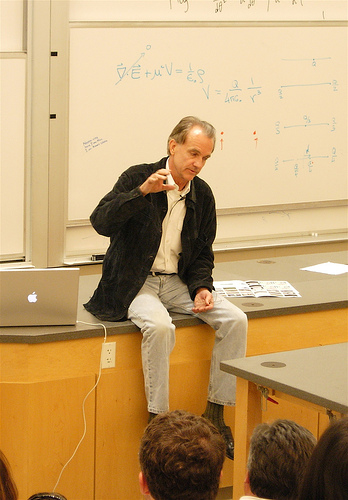Personal Utopia
Edward Tufte, whose books I call the Kama Sutra of information design, spoke at Stanford one December evening, and I had the pleasure of being in attendance.
It was an unconventional talk, as academic lectures go, for Tufte was speaking “in the first person” about his own life: his origins in rural Nebraska, his education and formative years, his mentors who influenced his thinking, and the turning points that signaled moments of profound reorientation. As Tufte noted, for a sample size of N=1, the estimated variance is infinite; so other sources should be consulted.

Edward Tufte at Stanford, 2006. Photo by Daniel Steinbock.
Tufte has had a remarkable career and speaks as someone who appears to have found the courage to follow his bliss, leaving a tenured professorship at Yale to self-publish his famous books on visual information, go on speaking tours, and make large-scale landscape art in his Connecticut backyard.
There were three principles I took away from his talk, summarizing Tufte’s notion of a life well-lived.
Contribute to ‘forever knowledge.’
The most important decision a researcher makes is choosing what problem to focus on. One should choose problems that are not only profoundly important, but ones for which good progress is possible. It’s worth nothing to work on grand problems and make no progress. Tufte’s own compass for this decision: contribute to Forever Knowledge. That is, create knowledge that will be universally useful to humankind in any time or place in human history. Tufte ditched his career as a political economy theorist because he found he was working on only temporarily important problems, things he decided were not worth his “time, energy, passion and mind.”
Be self-exemplifying.
In whatever one’s work, be not only a great communicator of ideas and practices, be an exemplar of those same practices and this will communicate the value of what you are saying far better than anything else. Tufte’s books are not only superb treatises on the visual display of information, they are also exemplary demonstrations of clear visual communication. I call them the Kama Sutra of information design.
Strive for personal utopia.
Here again, Tufte is, as he presents it, self-exemplifying. While utopian cultures may be unattainable, you can pretty well approximate an ideal life through clarity of purpose, courage to act on that purpose, and, most importantly, doing what you love.
Shall we follow?
Tufte opened his talk with a poem, excerpted from T. S. Eliot’s Four Quartets. I’ll leave it to you to interpret what he meant by it.
Time present and time past
Are both perhaps present in time future
And time future contained in time past.
If all time is eternally present
All time is unredeemable.
What might have been is an abstraction
Remaining a perpetual possibility
Only in a world of speculation.
What might have been and what has been
Point to one end, which is always present.
Footfalls echo in the memory
Down the passage which we did not take
Towards the door we never opened
Into the rose-garden. My words echo
Thus, in your mind.
But to what purpose
Disturbing the dust on a bowl of rose-leaves
I do not know.
Other echoes
Inhabit the garden. Shall we follow?